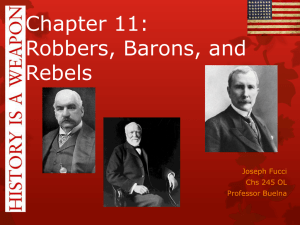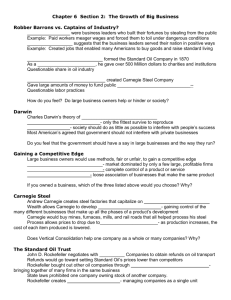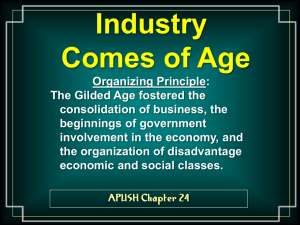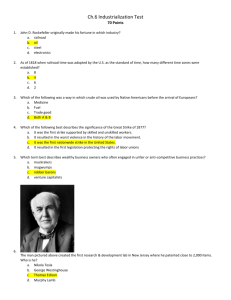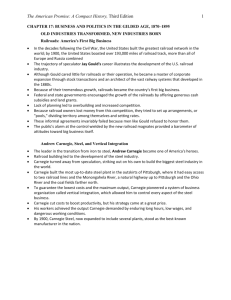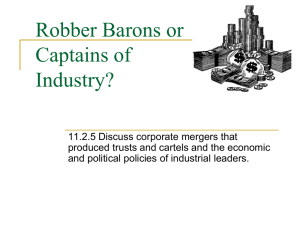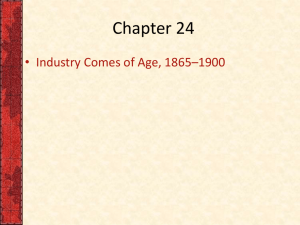AP_97th_Day_Feb_1_2013 - Baltimore Polytechnic Institute
advertisement
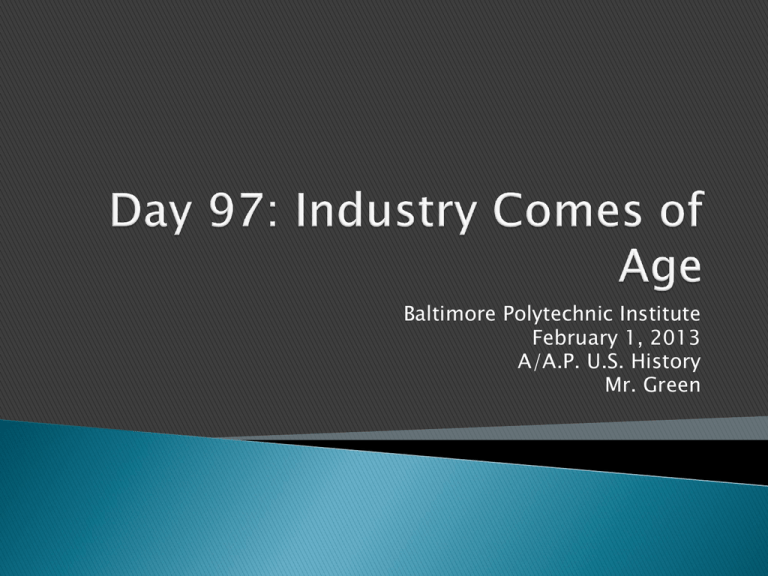
Baltimore Polytechnic Institute February 1, 2013 A/A.P. U.S. History Mr. Green Students will analyze to what extent the big monopolies (steel, oil, railroad) contributed to class conflict by describing the role of the industry leaders. Objectives: Explain how the transcontinental railroad network provided the basis for an integrated national market and the great post– Civil War industrial transformation. Identify the abuses in the railroad industry and discuss how these led to the first efforts at industrial regulation by the federal government. Describe how the economy came to be dominated by giant trusts, such as those headed by Carnegie and Rockefeller in the steel and oil industries, and the growing class conflict it precipitated. Describe how new technological inventions fueled new industries and why American manufacturers increasingly turned toward the mass production of standardized goods. AP Focus Enormous immigration, mass production, and the presence of low-skill jobs drive down workers’ wages. A catalyst for postwar industrial and economic expansion is the railroad industry, which not only facilitates trade, commerce, and transportation, but also makes locomotive production a major industry. The government plays a major role in the industry’s development and importance by providing the companies with millions of acres of free land—a giveaway, some say. CHAPTER THEMES America accomplished heavy industrialization in the post–Civil War era. Spurred by the transcontinental rail network, business grew and consolidated into giant corporate trusts, as epitomized by the oil and steel industries. Industrialization radically transformed the practices of labor and the condition of the American working people. But despite frequent industrial strife and the efforts of various reformers and unions, workers failed to develop effective labor organizations to match the corporate forms of business. Submit Election Charts for 1884, 1888, 1892, 1896 The wealthy class is becoming more wealthy; but the poorer class is becoming more dependent. The gulf between the employed and the employer is growing wider; social contrasts are becoming sharper; as liveried carriages appear; so do barefooted children Henry George, 1879 To what extent do you agree or disagree with the above quote? How is the above argument utilized in today’s political narratives? Foreign investors put the money into the hands of the private borrower Innovations in transportation-coal, iron, oil Mesabi Range-Chicago-Cleveland Mass-production methods 440,000 patents issued between 1860 and 1890 Bell and Edison Vertical integration-combining into 1 organization all phases of manufacturing Justified on the grounds of efficiency and quality Horizontal integration-Trust developed by Rockefeller to control competitors Interlocking directorates-J.P. Morgan placed his people in the businesses he bailed out Capital Goods vs. Consumer Goods Can you explain the difference 1870’s-Vanderbilt imported steel from Britain to update iron rails 1900-U.S. produced 1/3 of world’s steel Bessemer process-cold air blown on red-hot iron caused the metal to become white-hot by igniting the carbon eliminating impurities Accumulated capital and entered steel business in Pittsburgh 1900-produced ¼ of U.S. Bessemer steel Financial giant-J.P. Morgan made money and reputation by financing railroads, insurance companies and banks Carnegie sold holdings to Morgan for $400 million Carnegie spent the rest of his life giving away his money Morgan reorganized the holdings to form U.S. Steel capitalized at 1.4 billion Drake’s Folly initiates oil boom in 1859 Kerosene burns brighter and is the 4th most valuable export Edison makes kerosene obsolete Internal combustion engine gives oil a 2nd chance John D. Rockefeller organized Standard Oil in Ohio Controlled 95% of refineries in US by 1877 Consolidation made oil cheaper and better Trusts developed in sugar, tobacco, leather, harvester A new rich develops God given right to wealth Social Darwinists rich demonstrated greater abilities than the poor Herbert Spencer coined the phrase “survival of the fittest” This theory justified imperialism The new rich gained wealth on their own 14th amendment utilized by the monopolies to define a corporations as a person, affording the business the right to due process Sherman Anti-Trust Act of 1890 largely ineffective except to ban unions which restrained trade Plantation system degenerated into sharecropping Machine-made cigarettes James Buchanan Duke-American Tobacco Company/Duke University South kept subservient to Northern manufacturing Textiles brought to the South for cheap labor Entire families worked at Mill Towns, earning credit to buy food from the company store Using the Textbook from pages 583-592, identify 10 impacts of the new industrial revolution in America. Number your paper to ten. Each impact should be at least one sentence. You need to include labor unions as well as family impacts. You will read two primary source documents and answer the following questions for each selection 1. In Praise of Mechanization (1897) a. How does Levasseur (author of the selection) appraise the overall impact of mechanization? Is he convincing? Explain b. What differences does Levasseur see between work conditions in Europe and those in the U.S.? C. What does Levasseur identify as the principal complaints of U.S. workers? Does Levasseur consider them justified? You will read two primary source documents and answer the following questions for each selection A Tailor Testifies(1883) a. What changes in work conditions had the tailor seen in his lifetime? Explain b. Were the above changes for better or worse? Be specific c. What did the changes imply for his family life? Begin Reading first ½ of Chapter 25 Prepare for 5QQ on Tuesday 1880s Decade Chart due on Monday-No late assignments will be accepted.



